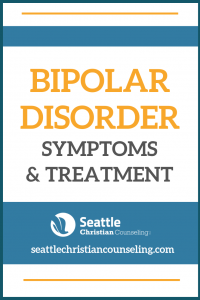Bipolar Disorder is a disorder of the brain that results in significant, often cyclical, changes in mood, energy and activity levels resulting from those changes. The range of moods can include extreme highs (elation, high energy, activity in overdrive) and extreme lows (despondent, can’t get out of bed, suicidal).
The “up” episodes are called manic (if severe) or hypomanic (if less severe), and the “down” episodes are called depressive. Depending on the severity of the symptoms, any one of four diagnoses is usually indicated.
Types of Bipolar Disorder
Before reviewing the symptoms associated with Bipolar Disorder, it is important to remember not to self-diagnose. Anytime you are concerned you may have a mental illness, set up an appointment with a mental health professional who can give you a proper diagnosis. If you think you may have Bipolar Disorder, the appointment should be with a psychiatrist, as the most important first step in treatment for this is often medication.

The two main types of Bipolar Disorder (I and II) are differentiated by the seriousness of the “up” episode. If the severity of the symptoms qualifies as manic, you can have a diagnosis of Bipolar I. If the severity never gets past hypomanic, you can have a diagnosis of Bipolar II.
The National Institute of Mental Health (NIMH) summarizes the types this way:
- Bipolar I Disorder – defined by manic episodes that last at least 7 days, or by manic symptoms that are so severe that the person needs immediate hospital care. Usually, depressive episodes occur as well, typically lasting at least 2 weeks. Episodes of depression with mixed features (having depression and manic symptoms at the same time) are also possible.
- Bipolar II Disorder – defined by a pattern of depressive episodes and hypomanic episode, but not the full-blown manic episodes described above.
- Cyclothymic Disorder (also called Cyclothymia) – defined by numerous periods of hypomanic symptoms as well as numerous periods of depressive symptoms lasting for at least two years (one year in children and adolescents). However, the symptoms do not meet the diagnostic requirements for arrival manic episode and the depressive episode.
- Other specified an unspecified bipolar and related disorders-defined by bipolar disorder symptoms that do not match the three categories listed above.

The key inclusion in the DSM-5 for a manic episode is that “the mood disturbance is sufficiently severe to cause marked impairment in social or occupational functioning or to necessitate hospitalization to prevent harm to self or others, or there are psychotic features.”
It also lists possible symptoms of a manic episode as:
- Inflated self-esteem or grandiosity
- Decreased need for sleep (e.g., feels rested after only 3 hours of sleep)
- More talkative than usual or pressure to keep talking
- Flight of ideas or subjective experience that thoughts are racing
- Distractibility (i.e., attention too easily drawn to unimportant or irrelevant external stimuli), as reported or observed
- Increase in goal-directed activity (either socially, at work or school, or sexually) or psychomotor agitation (i.e., purposeless non-goal-directed activity)
- Excessive involvement in activities that have a high potential for painful consequences (e.g., engaging in unrestrained buying sprees, sexual indiscretions, or foolish business investments)

A hypomanic episode may have any of the features listed above, but will not be severe enough to cause significant impairment in social or occupational functioning or require hospitalization. It has to have lasted at least 4 consecutive days for most of the day nearly every day. If there are psychotic features, the episode is manic (not hypomanic).
Psychotic features typically involve some kind of break from reality, such as delusions (believing something not true – not a fantasy, but actual belief), hallucinations (experiencing something not true, i.e. seeing or hearing something or someone that isn’t there), paranoia (believing you are under a threat that doesn’t exist, i.e. someone or something out to get me – a paranoid delusion would be a belief, for example, that a monster from a movie or video game was actually coming for you), or some other break with reality.
Mood-congruent psychotic features line up with the mood of the person, as with a depressed mood coupled with delusions of inadequacy, guilt or worthlessness. Mood-incongruent psychotic features don’t line up with the mood of the person.
On the other end of the cycle is a major depressive episode, which requires five or more of the following symptoms during the same two-week period, which represent a change from previous functioning:
- Depressed mood most of the day, nearly every day, as indicated by either subjective report (e.g., feels sad, empty, or hopeless) or observation made by others (e.g., appears tearful). (Note: in children and adolescents, can be irritable mood.)
- Markedly diminished interest or pleasure in all, or almost all, activities most of the day, nearly every day (as indicated by either subjective account for observation)
- Significant weight loss when not dieting or weight gain (e. g., a change of more than 5% of body weight in the month) or decrease or increase in appetite nearly every day. (Note: in children, consider failure to make expected weight gain.)
- Insomnia or hyper Sonya nearly every day
- Psycho motor agitation or retardation nearly every day (observable by others; not merely subjective feelings of restlessness or being slow down)
- Fatigue or loss of energy nearly every day
- Feelings of worthlessness or excessive inappropriate guilt (which maybe delusional) nearly every day (not merely self-reproach or guilt about being sick)
- Diminished ability to think or concentrate, or indecisiveness, nearly every day (either by subjective account or as observed by others)
- Recurrent thoughts of death (not just fear of dying), and recurrent suicidal ideation without a specific plan, or a suicide attempt or a specific plan for committing suicide.
Treatment Options for Bipolar Disorder
Medication
 Depending on the type and severity of symptoms, a doctor may prescribe any of a number of medications; mood stabilizers to manage depression or anxiety, atypical antipsychotics if there are psychotic features as described above, and antidepressants.
Depending on the type and severity of symptoms, a doctor may prescribe any of a number of medications; mood stabilizers to manage depression or anxiety, atypical antipsychotics if there are psychotic features as described above, and antidepressants.
It is important to follow the instructions of your doctor and not change dosage without consulting him or her. Talk to them and be sure you understand the potential risks and benefits. Finding the right medication and dosage can be hit or miss, and it may require patience to keep trying.
Psychotherapy
Done in conjunction with medication, psychotherapy can help a patient decrease the negative impacts of the disorder. What we believe about our condition can have a significant effect on how we experience the symptoms.
If we allow our mind to get stuck in a negative belief, like “I’m always going to feel this way” we can ride that thought right down into despair or up into a full blown panic attack.
With professional help, we can learn more about how we are triggered by our defensive structures and family of origin (family-focused therapy, interpersonal therapy, psycho-education, and others), and learn to identify and disrupt unhelpful ways of thinking (cognitive behavioral therapy).
Electroconvulsive Therapy (ECT) – Some people with severe Bipolar Disorder have been helped by ECT, especially when they have not been able to improve with other treatments. Short-term side effects may include disorientation, confusion and memory loss. As with all treatments, you should always discuss possible benefits and risks with a qualified health professional.
“font-size: 24px; font-weight: bold;” When Do I Seek Treatment?
As with all such medical considerations, the decision to seek treatment lies with the individual, unless the individual is incapacitated by the illness and someone else has to intervene. Typically, the severity of the symptoms and the significance of the impact on your function at work, at home or with friends are going to be your primary indicators.
One of the peculiar things about being bipolar is that during the “up” phase, a person may feel very good like they can take on the world, able to work long hours. Others may praise the person as a hard worker, very productive, and money may follow the praise, in the work setting. These can all be strong incentives not to “upset the apple cart” by getting treatment. Consider the following fictional story:
Rebecca was always a hard worker, good at household chores, finished her homework on time and got good grades in high school. She didn’t sleep much, maybe 4 or 5 hours a night, except for what she called her “down weeks” where it was hard to get out of bed at all. She learned early on that if she forced herself out of bed and ran a few miles, she could give herself enough of a kick-start to make it through the day.

It never occurred to her to write down these changes, and she chalked them up to hormones, changing weather or whatever. College was a breeze, except for her down weeks, but she found that in addition to exercise, stimulants like coffee and occasionally something stronger, would carry her through. After she graduated, she went to work at a software company writing code.
Her productivity was such that when she asked if she could work 10 hour days some weeks and six hour days on others, her boss was happy to agree. Her 10 hour days were sometimes 14 hours, and her 6 hour days sometimes 4 hours, but her output still put her at the head of the pack on her dev team. Two years into the job, she fell in love and got married. This forced her to normalize her hours a bit, so she would have time to spend with her spouse.
She started drinking more in the evenings to calm herself down, and on her down weeks, she started taking stronger stimulants. Her sleep dropped to about 3 hours a night whether she was up or down. Things began to unravel at work; missed deadlines, mistakes, and at home she grew more and more irritable, to the point she didn’t want to come home after work.
Faced with probation at work and increasing unhappiness at home, she decided to see a doctor. A friend recommended a psychiatrist, and by the end of the first session, she had a diagnosis of Bipolar Disorder.
The psychiatrist prescribed medication, and after a month to get the dosage right, she found herself much better able to work normal hours, slept better and had less irritation. She sometimes missed the elated surge of energy she used to have that let her work like a machine, but she found that she could be almost as productive and not have to sacrifice her relationships or her health to do it.
Rebecca’s story is fictional, with a tidy solution not unlike a one-hour drama on television. As with any illness, there is no guarantee that a solution will come easy, or even come at all. But we do well to try. There are as many variations to this disorder as there are people who have it.
The things to carry away from this story are, first, when she realized she needed help, she went out and got it, and second, she stuck with it until she got the help she needed. Some might feel shame for not noticing sooner that they had a mental disorder for years, even decades, and didn’t know it.
Sometimes we have a disorder that we are able to manage for a time. We didn’t notice it coming on because it happens inside us and sometimes it doesn’t occur to ask the question, “why?” To paraphrase C.S. Lewis, once an unhealthy path is illuminated, it is the person who changes course first who is making progress.
Closing Thoughts
Despite the increase in awareness around mental health issues and availability of services, there is still some stigma attached to it. If no one you know has sought treatment for mental illness, you may have a lot of resistance to scheduling an appointment with a therapist or psychiatrist. Throughout our lives, we periodically need help from professionals; to fix our cars, to help with taxes, to diagnose physical illness, and sometimes to diagnose mental illness.
If you are experiencing symptoms that are negatively impacting your work, your home life or your friendships, the sooner you see a mental health professional and get a diagnosis, the sooner you can begin the important journey toward health and better ways of being.
“Young Woman Dancing,” courtesy of Bold Content, Flickr CreativeCommons (CC BY 2.0); “Portrait,” courtesy of Cassandra Jowett, Flickr Creative Commons, CC0 License; “Reflect,” courtesy of Clem Onojeghuo, unsplash.com, CC0 License; “Long Distance,” courtesy of Chris Lawton, tookapic.com, CC0 License




